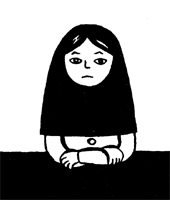
There is no particular reason to mention Marjane Satrapi at this moment in time: there is no new book out, I have not read anything new by her in over a year and many people reading this will already be familiar with her work. But there are snippets of news concerning the woman who has become probably the world's most famous Iranian artist, mainly through her superlative graphic novel Persepolis, originally published in French from 2000 to 2003, and which has since done the rounds of most the world's major languages. Next language up is Arabic, for an edition that had been due to be published by a Lebanese publisher in September. Whether the house in question has managed to weather the Israeli Defence Force's 'restructuring' of Lebanon is unknown, but the appearance of this fine work in Arabic would be truly ground-breaking, even if an edition in Satrapi's native language Farsi remains, sadly, a long way off. In addition to this there is the animated film version of the book, due to be released next year, to be co-directed by Satrapi with Vincent Paronnaud, with the voices of Chiara Mastroianni as Marjane and Mastroianni's real-life mother Catherine Deneuve as mother Satrapi.
For those that have not yet encountered Persepolis or any other Satrapi work, it is an autobiographical survey of life under the Islamic Revolution as a ten-year-old girl, and her later exile in Vienna attending a Catholic lycée and facing European prejudice and ignorance about her homeland. The book, aside from its narrative mastery, is distinguished by its heavily-inked visual style, which resembles wood-block prints and which casts its characters in semi-abstract physiognomies that Satrapi claims were the result of her being forbidden to draw realistic life studies in art college by the absurd strictures of the Islamic regime. It is a style that is also characteristic of L'Association, the Paris artists' co-operative that publishes Satrapi and which has also cultivated similarly distinctive styles in other artists such as Guy de Lisle, David B, and the already-established Swiss comic artist Johann Sfar.
Satrapi is technically a princess, being directly descended from the pre-Shah Persian kings, though her family, being Communist, have long abrogated that privilege. She now lives in Paris, on Place de Vosges, a mere ten minute walk from where I sit typing away now. Since Persepolis, she has won the Album of the Year award at Angoulême (the graphic novel equivalent of the Cannes Film Festival) twice, for Broderies (translated into English last year as Embroideries) and her last work Poulet aux prunes (as yet unavailable in English), a disarmingly simple tale of a musician uncle that died of a broken heart in the 1950s, that nonetheless moves in a new direction both structurally and thematically. It is one of the great ironies of the modern age that a country with as rich and great a civilisation as Iran should have to be explained to Westerners by comic books. Marjane Satrapi's books, even if they ever appear in Farsi, are unlikely to bring down the Ayatollahs but they should convince doubting people in Europe and North America of the folly of imposing another war on an innocent people in order to implement 'regime change'.





0 comments:
Post a Comment